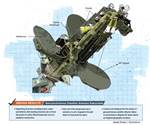Composites support SKA Observatory radio telescope sub-reflectors
Engineering company Eosol and composites developer Compoxi work together to deliver more than 250 4.5-meter composite dishes to construct two cosmos-focused telescopes.
Global engineering, monitoring and technical support services company Eosol Group (Pamplona, Spain), together with Compoxi (Girona, Spain), a composite structures designer and developer, is building sub-reflectors for the SKA Observatory’s mid-frequency telescope known as SKA-Mid, which is currently under construction in South Africa. This is claimed to be the largest contract awarded to Spanish companies to date.
The SKAO, an intergovernmental organization composed of member states from five continents and headquartered in the U.K., has a mission to build and operate radio telescopes to transform our understanding of the science and its key processes, including the formation and evolution of galaxies, fundamental physics in extreme environments and the origins of life. Its two telescopes, each composed of hundreds of dishes and thousands of antennas, are being constructed in South Africa and Australia.
The telescope’s sub-reflector is one of the critical parts of the dish that serves to focus the signals collected by the larger main reflector into a feed, where the signal processing journey begins. Each sub-reflector is a 4.5-meter structure made of composites and metallized to achieve the electromagnetic and mechanical properties required for the project.

In Australia, the low-frequency array, known as SKA-Low, will eventually comprising 131,072 antennas spread across 74 kilometers. In South Africa, SKA-Mid will ultimately have 197 dishes (incorporating the existing 64-dish MeerKAT radio telescope) spread across 150 kilometers. The SKA telescopes’ size and large number of antennas and dishes means there will provide a significant leap in resolution, sensitivity and survey speed, seeing more of the universe, and in greater detail. According to partners, the array design and processing capacity will also enable radio astronomers globally to study different parts of the cosmos simultaneously by forming sub-arrays.
“The SKA-Mid sub-reflector is a technically challenging design; the surface requires high levels of accuracy and is a critical optical component to reflect the distant weak astronomical signal to the detectors precisely,” says SKAO dish project manager Mark Harman. “It also needs to be very stiff to withstand the environmental conditions. We are impressed with Eosol and Compoxi’s capabilities and are excited to be working with them on this project as we now begin to prepare for the construction activities in the coming year.”
The radio telescopes are currently under construction, with early science verification expected to begin with partial arrays in late 2026, and the science capabilities growing as construction continues over the next 6 years.
This contract is partially funded by the European Union – NextGenerationEU, managed by the Ministry of Science, Innovation and Universities.
Related Content
-
NASA launches composite solar sail into space
Sunlight-based propulsion system, supported by carbon fiber-reinforced booms, will undergo weeks-long testing to demonstrate and verify its capabilities.
-
High-temperature composite 3D printing facilitates design, manufacture of deployable space structures
Opterus R&D employs an AON3D printer and OOA prepregs to build the tooling, prototypes and end-use versions of its foldable CFRP satellite structures.
-
Orbital Composites wins award from U.S. Space Force to build space factories for antennas
Partners Axiom Space, Northrop Grumman Space Logistics and Southwest Research Institute will help advance ISAM technologies for kilometer-scale LEO antennas, space stations and GEO applications, targeting space factory in 3-5 years.

















